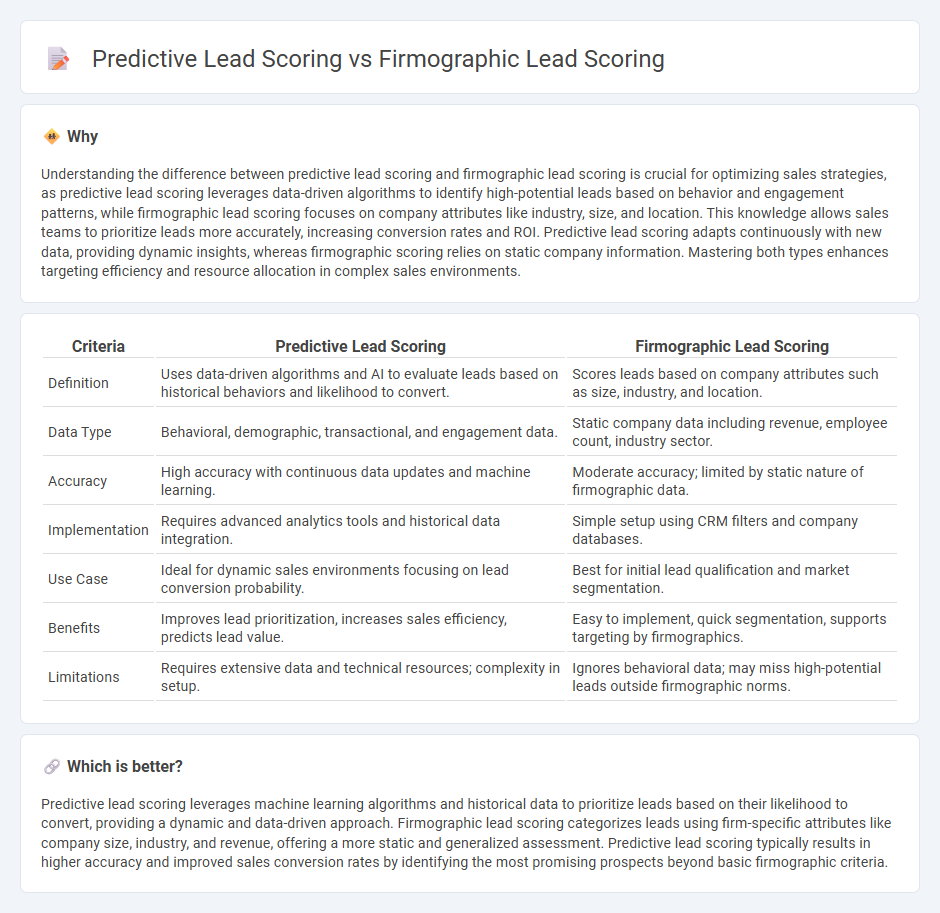
Predictive lead scoring uses historical data and machine learning algorithms to identify high-potential prospects, improving sales efficiency by focusing on leads most likely to convert. Firmographic lead scoring categorizes prospects based on company attributes such as industry, size, and location, providing a basic framework for lead prioritization. Discover how combining these approaches can enhance your sales strategy and boost conversion rates.
Why it is important
Understanding the difference between predictive lead scoring and firmographic lead scoring is crucial for optimizing sales strategies, as predictive lead scoring leverages data-driven algorithms to identify high-potential leads based on behavior and engagement patterns, while firmographic lead scoring focuses on company attributes like industry, size, and location. This knowledge allows sales teams to prioritize leads more accurately, increasing conversion rates and ROI. Predictive lead scoring adapts continuously with new data, providing dynamic insights, whereas firmographic scoring relies on static company information. Mastering both types enhances targeting efficiency and resource allocation in complex sales environments.
Comparison Table
| Criteria | Predictive Lead Scoring | Firmographic Lead Scoring |
|---|---|---|
| Definition | Uses data-driven algorithms and AI to evaluate leads based on historical behaviors and likelihood to convert. | Scores leads based on company attributes such as size, industry, and location. |
| Data Type | Behavioral, demographic, transactional, and engagement data. | Static company data including revenue, employee count, industry sector. |
| Accuracy | High accuracy with continuous data updates and machine learning. | Moderate accuracy; limited by static nature of firmographic data. |
| Implementation | Requires advanced analytics tools and historical data integration. | Simple setup using CRM filters and company databases. |
| Use Case | Ideal for dynamic sales environments focusing on lead conversion probability. | Best for initial lead qualification and market segmentation. |
| Benefits | Improves lead prioritization, increases sales efficiency, predicts lead value. | Easy to implement, quick segmentation, supports targeting by firmographics. |
| Limitations | Requires extensive data and technical resources; complexity in setup. | Ignores behavioral data; may miss high-potential leads outside firmographic norms. |
Which is better?
Predictive lead scoring leverages machine learning algorithms and historical data to prioritize leads based on their likelihood to convert, providing a dynamic and data-driven approach. Firmographic lead scoring categorizes leads using firm-specific attributes like company size, industry, and revenue, offering a more static and generalized assessment. Predictive lead scoring typically results in higher accuracy and improved sales conversion rates by identifying the most promising prospects beyond basic firmographic criteria.
Connection
Predictive lead scoring and firmographic lead scoring are interconnected by leveraging data-driven insights to prioritize sales prospects effectively. Predictive lead scoring uses historical and behavioral data to forecast a lead's likelihood to convert, while firmographic lead scoring examines company attributes such as industry, size, and revenue to assess lead quality. Combining these methods enhances targeting accuracy, enabling sales teams to focus on high-potential leads with a higher probability of closing.
Key Terms
Firmographic Lead Scoring:
Firmographic lead scoring evaluates prospects based on firm-specific attributes such as company size, industry, location, and revenue, enabling targeted outreach to companies most likely to convert. This method helps sales and marketing teams prioritize leads by aligning firmographic data with ideal customer profiles and business goals. Discover how integrating firmographic insights can enhance your lead qualification process and boost conversion rates.
Company Size
Firmographic lead scoring evaluates potential leads based on company size, industry, and location, categorizing businesses into segments such as small, medium, or large enterprises. Predictive lead scoring leverages machine learning models that analyze a broader set of variables, including company size, to forecast lead conversion probability more accurately. Explore how combining these approaches can optimize your lead generation strategy.
Industry
Firmographic lead scoring evaluates potential clients based on static business attributes such as industry, company size, and location, emphasizing the direct impact of industry classification on lead prioritization. Predictive lead scoring employs advanced algorithms and historical data patterns to forecast lead conversion likelihood, integrating firmographic factors like industry alongside behavioral and engagement metrics. Explore how combining both methods enhances targeting precision and boosts conversion rates.
Source and External Links
Lead Scoring Examples - This article discusses firmographic lead scoring, which involves assessing leads based on company characteristics like industry, revenue, and company size to align with the ideal customer profile.
Lead Scoring: Best Practices and Techniques - The firmographic score in lead scoring is built on elements such as job title, job role, and annual revenue to fit the ideal customer profile.
Lead Scoring: Definition, How To Score - Firmographic data in lead scoring includes company-related information like size, industry, and revenue to segment companies and tailor marketing efforts.
 dowidth.com
dowidth.com